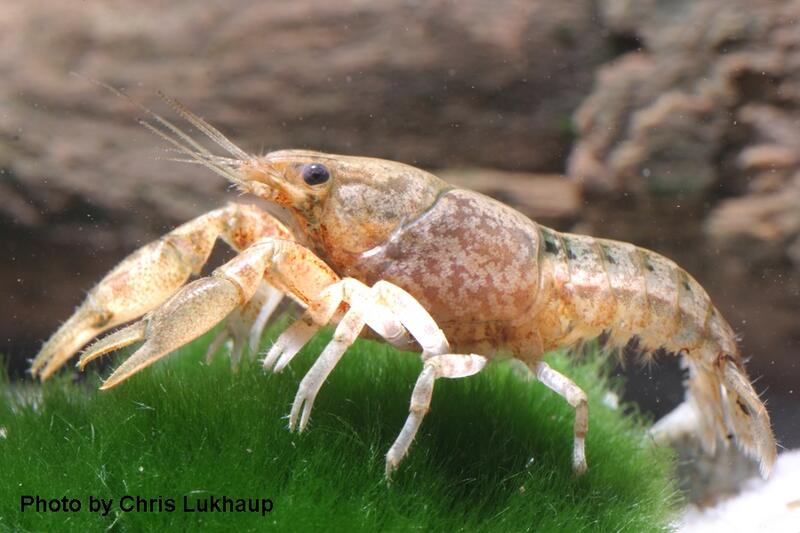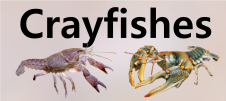







Loading profile. Please wait . . .
Faxonella clypeata (Hay, 1899)
Ditch Fencing Crayfish




Federal Protection: No US federal protection
State Protection: No Georgia state protection
Global Rank: G5
State Rank: S5
Element Locations Tracked in Biotics: No
SWAP 2015 Species of Greatest Conservation Need (SGCN): No
SWAP 2025 Species of Greatest Conservation Need (SGCN): No
2025 SGCN Priority Tier: None
Element Occurrences (EOs) in Georgia: 0
Habitat Summary for element in Georgia: Temporary habitats such as ditches, shallow ponds, and streams, and simple burrows adjacent to those habitats
The overall color of the Ditch Fencing Crayfish is light brown to light reddish brown with darker mottling. Some individuals have a pale center stripe along the entire length of the body, and on some males, the claws have a reddish tint. The moveable finger of the claw is shorter than the mesial margin of the palm; this is unique to Georgia crayfishes. The areola is wide and the rostrum is broad and typically rounded in appearance, very rarely with marginal spines or tubercles. This species reaches a maximum total body length of about 44 mm (1.7 in).
No other Georgia crayfish possess a moveable finger shorter than the mesial margin of the palm.
The Ditch Fencing Crayfish can be found in temporary aquatic habitats such as ditches, shallow ponds, small to medium sized streams, and wooded wetlands. When water levels drop in these temporary habitats, this species will burrow.
No studies of this species are known. Crayfishes are considered opportunistic omnivores and likely feed on live and decaying vegetation, aquatic insect larvae, small fishes, and dead animal matter.
Despite having examined over 1200 specimens from Georgia, little is known of the life history of this species within the state (Hobbs 1981). Males in reproductive condition have been collected in all months except January and May, and October through December (Fitzpatrick 1963, Hobbs 1981). However, collections during May are lacking, and since reproductive males have been found in April and June, they will certainly be found in May. Females with eggs have not been found in Georgia but were reported from September to December in Louisiana (Smith 1953). The smallest male in reproductive condition is about 20 mm (0.8 in).
Dipnetting or seining in shallow temporary habitats or excavating burrows adjacent to these types of habitats.
Southeastern Oklahoma and northeastern Texas to central South Carolina (Hobbs 1989). In Georgia it is restricted to the Coastal Plain (except for an old record in Harris County) and has been found in all of the major drainage systems except the Savannah (Hobbs 1981).
Activities that destroy streams or alter hydrology where temporary aquatic habitats occur threaten this species.
This species is widespread and common and considered stable in Georgia.
Conserving populations of the Ditch Fencing Crayfish will require general watershed level protection measures, including the protection of riparian zones, control of sediment and nutrient runoff from farms and construction sites, and limiting the amount of impervious cover (e.g., pavement) within occupied watersheds. Non-native crayfishes should never be used for bait; instead, anglers should use crayfishes collected from the river system where they will be fishing. Unused bait of any kind should not be released back into Georgia waters.
Hobbs, H.H., Jr. 1981. The crayfishes of Georgia. Smithsonian Contributions to Zoology 318:1–549.
Hobbs, H.H., Jr. 1989. An illustrated checklist of the American crayfishes (Decapoda: Astacidae, Cambaridae, and Parastacidae). Smithsonian Contributions to Zoology 480:1–236.
Smith, E.W. 1953. The life history of the crawfish Orconectes (Faxonella) clypeatus (Hay) (Decapoda, Astacidae). Tulane Studies in Zoology 1:79–96.
Taylor, C.A., G.A. Schuster, J.E. Cooper, R.J. DiStefano, A.G. Eversole, P. Hamr, H.H. Hobbs III, H.W. Robison, C.E. Skelton, and R.F. Thoma. 2007. A reassessment of the conservation status of crayfishes of the United States and Canada after 10+ years of increased awareness. Fisheries 32:372–389.
Christopher E. Skelton
C. Skelton, 2012: original account
C. Skelton, February 2019: general update of account
D.Weiler, September 2019: Photo added .